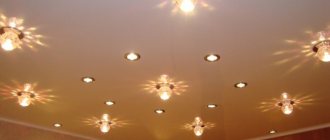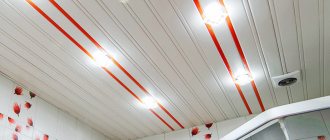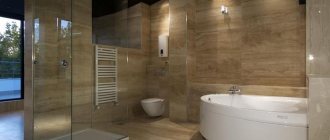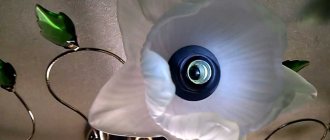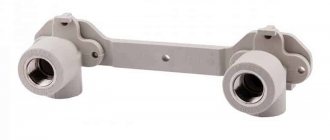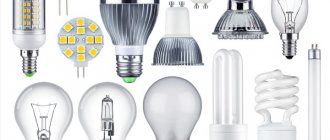11/17/2016 master
Repairing the ceiling is quite a responsible undertaking, which, among other things, involves a wide variety of calculations. Here it is necessary not only to calculate the repair budget, but also to correctly calculate how many lamps, especially if spotlights will be used, will need to be installed. To find out, the first thing you need to do is decide what distance between the lamps should be.
Ceiling lamps
Moreover, such calculations are important not only for creating a general lighting system in the house, but also in production (for example, for security, emergency, etc. types of lighting). Our article will tell you about everything related to this type of calculation.
Why is the calculation carried out?
According to regulatory documentation (SNiP, SanPin), the lighting system in any room must comply with certain requirements, which primarily relate to the level of illumination. Each home or industrial premises must have its own lighting levels, which are implemented by different types of lamps (emergency, general, local, work and other purposes). All indicators of the degree of illumination for various rooms are given in SNiP. An example of the level of illumination that should be implemented in various rooms is given in the table.
Note! The required illumination level is shown in the table at a minimum level. Therefore, a slight upward adjustment is allowed.
Table. Indoor lighting level
Such standards were developed to ensure that people in the premises do not experience discomfort. To determine the optimal level of illumination for each specific room, the calculation must take into account a number of indicators:
- type and purpose of the premises;
- type of lighting (general, emergency, work or other purposes);
- type of lamps, as well as their location (on the ceiling, wall, work surface);
- type of light source. For lighting a home and industrial premises (security, emergency, work purposes), the calculation can use the operating parameters (power, etc.) of incandescent, LED, fluorescent and other types of lamps.
Types of light bulbs
However, it is not enough to know the above indicators. The calculation must also determine how many light bulbs and luminaires need to be used to create the level of illumination required by SNiP standards. And to find out, you need to find out what the distance will be between the lamps used. If you do not make such a calculation, then you are unlikely to be able to create eye-pleasing lighting in the room. Moreover, this calculation is most complex for industrial facilities when organizing emergency, work, general and other lighting options.
Characteristics
As a standard, the described luminaries consist of several elements:
- Decorative detail. We are talking about lampshades, shades, covers, etc. This is the final editing touch.
- Frame. Provides frame and protective functions.
- Light source. Here is an ordinary lamp, which is purchased separately or a built-in LED module.
- Technique. This includes drivers, microcircuits, electrical connections, etc.
- Fasteners for installation.
Important! Lighting sources can be ordinary halogen, LED and incandescent lamps.
Lamps with a built-in module - a guarantee of safety and long service life
Recently, installers and manufacturers have been trying to switch completely to LED lamps with a built-in module, since other models have significant flaws in their operation: heating and dim light.
You may be interested in How to determine the lighting in an apartment
The most popular option with spotlights
Today, the most popular ceiling lighting option is spotlights. Most often, such lamps are used in homes and offices, as well as public buildings. A spotlight is a small lamp into which one light source is screwed (LED, halogen and fluorescent light bulbs).
Note! Very often, spotlights are used for illumination in suspended or plasterboard ceilings.
Spotlight on a suspended ceiling
Moreover, the technical characteristics of the lighting device allow it to be used in absolutely any room of the house (living room, bedroom, and even in the bathroom or kitchen). These are quite simple lamps in their design, when used, calculating and determining the distance between them will not be very difficult, unlike similar actions with lamps used in production (for organizing general, emergency and other lighting options). At the same time, do not forget that in addition to spotlights, you can use other lighting devices:
- pendant and ceiling chandeliers with different numbers of bulbs;
- industrial lamps;
- office lamps, etc.
In each area of human activity, lamps used to create emergency, general, work and other lighting options will differ in different technical characteristics, as well as dimensions and placement methods. Therefore, the calculation of the illumination level and the distance between the lamps used will be based on various parameters. But since industrial premises and the organization of various lighting options there (emergency, security, etc.) are a separate topic, we will focus in more detail on the most common option - spotlights. Using their example it will be easy to demonstrate how such a calculation should look.
Transformers for halogen lamps and transformers for LEDs: are they interchangeable?
The transformer for halogen lamps has its “relative” - the transformer for LED lighting. But even with the same rated power and output voltage, these transformers are not interchangeable devices.
The fact is that in a halogen lamp the light source is an incandescent filament. The glow of an LED involves completely different physics. Electric current passes through the P/N junction of the diode and releases part of the energy in the form of a photon of light. This difference in the physical phenomenon of the glow of a halogen lamp and an LED puts different requirements on transformers. Without going into a deep analysis of transformer oscillograms within the framework of this article, let’s make some inputs:
- 12V at the output of the electronic transformer is the average voltage. In reality, there are short-term surges up to 40V. A halogen lamp “swallows” this jump without damage, but for an LED it can be disastrous.
- In addition to short-term voltage surges, electronic transformers for halogen lamps are characterized by instability of the output voltage. It can be in the range of 11-16V and depends on the input network voltage, connected power, and ambient temperature.
- The halogen lamp transformer produces non-rectified voltage. It contains both positive and negative impulses. For long-term operation of the LED, a rectified voltage is required, the pulse amplitude graph of which is close to a straight line.
Halogen lamp protection block Granite
Halogen lamps have an unpleasant feature - they burn out when turned on. Conventional lamps, of course, also have this disadvantage, but not to such an extent.
Halogen and incandescent lamps, as a rule, burn out when turned on, when the filament is still relatively cold and its resistance is low. In this case, a large current jump occurs, and a short-term high power is released on the spiral. This effect is described in detail on SamElectric in the article.
To extend the life of halogen lamps, such a device was invented - a halogen lamp protection unit
. The principle of operation of the protection unit is extremely simple - since the lamp burns out at the moment of a sharp jump in current through it, this device is connected in series with the lamp and limits the current at the initial moment.
The current, and therefore the brightness, gradually increases over 1 - 2 seconds. Connecting the protection unit is not difficult. It has two terminals, polarity, input-output and phase-ground do not matter. It is better to connect it in series with the switch in a phase break.
Such a unit is sometimes called a soft starter, a protection device, or a protection device. The device is used not only for halogen, but also for conventional incandescent lamps.
What parameters affect calculations
In order to correctly carry out the calculation to calculate the distance between any lamps (even for security and emergency plans) on the ceiling, you must first evaluate their design features.
Spotlight design
The spotlight has a built-in housing that easily fits into structures with a suspended or plasterboard ceiling. Note! The design of the plasterboard or suspended ceilings themselves for different rooms (bedroom, bathroom, etc.) will be installed according to the same principle. Thus, if the room has a suspended ceiling structure, then installing a spotlight in it will take a minimum of time and effort. It is also worth noting that such lighting devices come in two types:
- built-in;
- invoices.
If built-in models require a suspended ceiling structure, then surface-mounted spotlights can be mounted on absolutely any surface, which makes them universal. It is precisely these lamps that can be found today in many public spaces, as well as at production and industrial facilities in the role of general, work or emergency lighting.
To place such a lamp, you only need a standard set of fasteners that will come with it. At the same time, do not forget that the very location of the lamps on the ceiling may be different. Here everything depends on the purpose of both the premises and the lighting system as a whole or its individual elements. This aspect must be taken into account in your calculations. Options for the location of lighting fixtures may be as follows:
- at equal intervals from each other. In this situation, they will create general and uniform lighting, preventing the appearance of shadows and poorly lit areas in the room;
Uniform placement of lamps
- zonal. This involves a concentration of lighting fixtures for better and more complete illumination of a specific area.
Note! In production, such a placement scheme is used to illuminate the work area or the place of each worker, and in the house - to visually delimit the space of the room, as well as for decorative purposes.
Zonal placement of lamps
It is these placement options that the calculation should be based on.
Device
Before installation, it is recommended to analyze two points:
- Lamp size. It is calculated depending on the object, the ceiling structure, the number of electrical appliances in the room, and the required power.
- Number of levels in the ceiling.
Pay attention to fire safety:
- non-flammable, heat-resistant cables;
- reliable connection method (via terminal blocks);
- correct determination of the required power.
Accenting with spotlights is a design move.
Next are the following stages of repair:
- Determining the type of ceiling. Rack and pinion - consists of a complex of narrow panels called slats and a hanging mechanism designed for fastening. Plasterboard - a lattice frame is folded, attached to the ceiling with connecting means. Tension - a canvas attached to a specific profile (made of aluminum or plastic) under the main ceiling.
- Designation and wiring in places previously marked on the plan.
- Ceiling installation.
- Cutting holes for spotlights of the required diameter using specialized tools.
- Connecting cables using terminal blocks. Finish the job with electrical tape or heat-insulating shrinkage.
- Fixing the device in a complete structure.
Depending on the design, two types of lamps are also distinguished.
Rotary
For rotating spotlights, the body together with the bulb can change the direction of light due to the presence of a hinge. This makes it possible to adjust the flow of “rays” to a certain place. These include:
- spots;
- chandeliers with rotating branches.
The standard rotary luminous apparatus includes:
- hinged part responsible for mobility;
- stationary element;
Attention! There is free space between the hinge and the stationary part, providing better ventilation.
- metal case with built-in base;
- bracket.
Rotating lamps - independent control of the flow of light.
Undeniable advantages (besides the obvious):
- various execution options;
- compactness of lamps;
- ease of installation;
- interaction with any light source.
There are no downsides as such. However, the cost makes itself felt.
Static
Fixed spotlights are designed for main (upper) lighting. They are used if the project does not provide for a central luminous element (chandelier or ceiling light). Then the points are located in groups on the main intersection areas.
Stationary lamps in the living room design
The device is firmly fixed in the ceiling space. Subsequently, the light flow is directed exclusively in one direction (mainly vertically).
They cost an order of magnitude cheaper than rotary ones. Which explains the lack of a turning mechanism.
Optimal solutions
Determining the distance between installed luminaires for each specific case must obey the following rules to create the optimal level of illumination:
- the distance between adjacent rows of lighting fixtures should not be more than 1 m;
- the distance from the wall to the lamp of the outermost row should not exceed 60 cm;
- the above requirements are relevant for rooms with a ceiling height of 2.5 m.
Lamp placement diagrams
These requirements were developed on the basis that at this height there will be an intersection of the cones of light that will be created by all lighting installations installed in the room. It must be remembered that the installed lamps should not fall on the frame elements. Also, when determining the distance between adjacent lamps, you need to rely on the material from which the ceiling is made. For example, if there is a suspended ceiling, the calculation is carried out based on the fact that per 1 sq.m. such a surface should receive lighting rated at 20 W.
The actual calculations
Schematic representation of the room
Determining the distance needed to install lighting fixtures on a ceiling (regular, suspended or plasterboard) comes down to figuring out how many lamps will need to be installed in the room (bedroom, bathroom, etc.). From this alone the distance between adjacent lamps will be calculated so that they can all fit in the room. Thus, for the calculation we need to know:
- type of lamps installed in the room;
- the power that the lamp has;
- the total area of the room in which the selected light bulbs and fixtures will be placed.
Knowing these three values, you can already make a competent calculation of the distance that should be between the selected lighting fixtures. But do not forget that before the calculation it is necessary to calculate such a parameter as the number of lamps themselves. The algorithm of actions in this case is as follows:
- find out the power of the lamp;
- Next, measure the area of the existing room (multiplying the length by the width);
Note! If the room has a non-standard shape, then special formulas must be used to calculate its area.
- Next we multiply the area by the power. Let's remember this number;
- then we find out its light emission in the device passport;
- after this, you need to divide the light emission power by the figure we got by multiplying the area of the room and the power of the lamp.
The resulting number (can be rounded up) will reflect the number of lighting fixtures that need to be installed in this room. Calculating the distance between the lighting installations themselves is quite easy. To do this, you need to know that the lamps on the ceiling should be placed evenly. When zoning a room, some of the light bulbs can be placed a little more closely. By maintaining the sequence of calculations, you will be able to independently carry out all the necessary calculations correctly and without any problems and ultimately obtain an accurate figure. In this case, the error in your calculations will be minimized.
